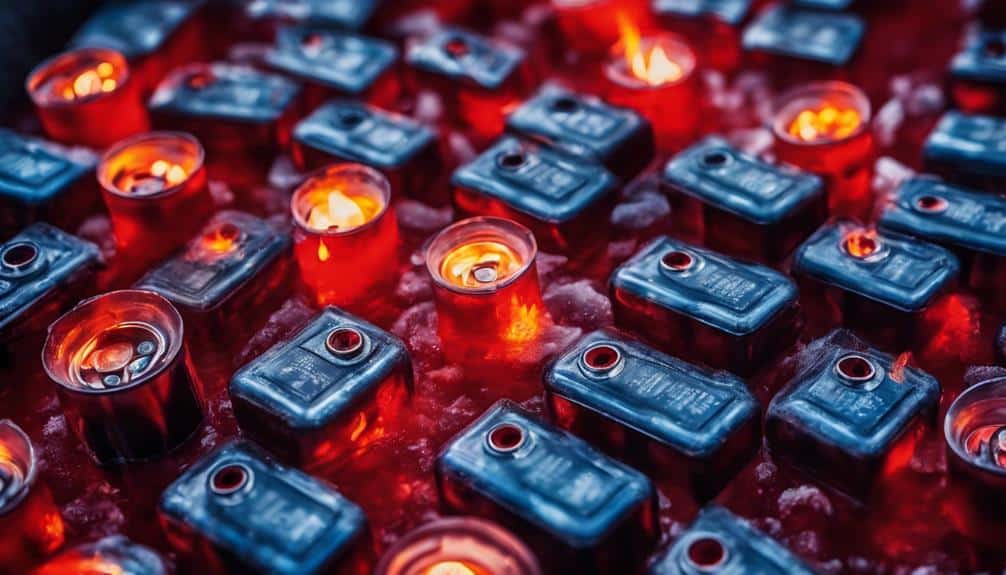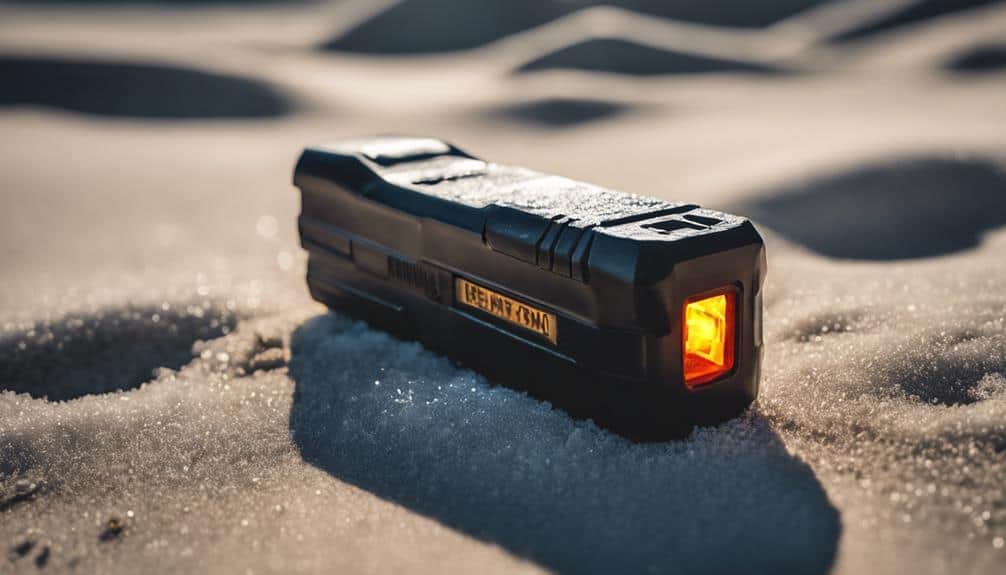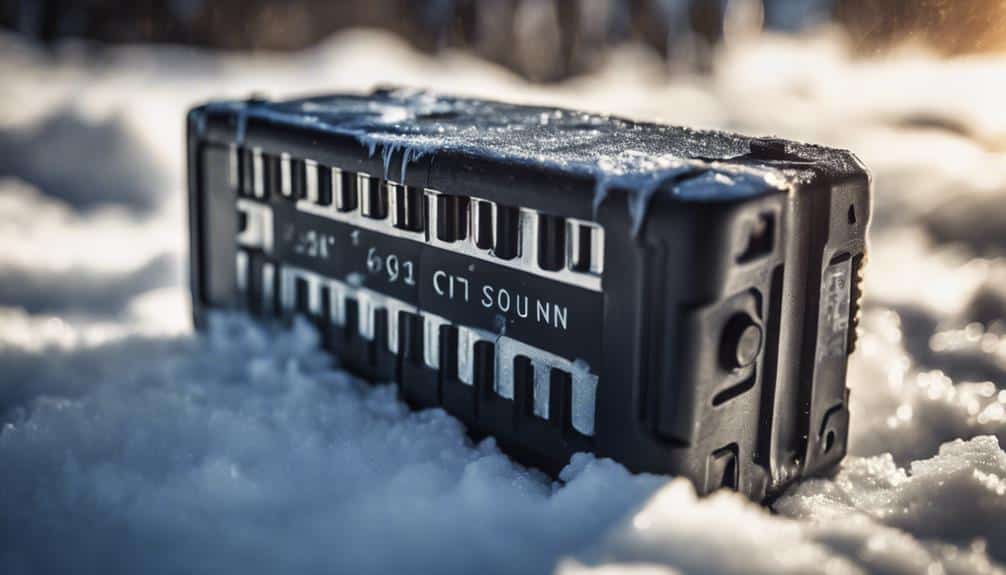Extreme temperatures are a real shocker for your stun gun’s battery, and not in a good way! In frigid conditions, especially with
lithium-ion batteries, efficiency nosedives due to increased internal resistance, leaving you with a surprise when your stun gun delivers a
weak zap. Imagine needing it in a pinch, only to find it’s as effective as a sleepy kitten. But fret not; keeping your stun gun warm close to your body helps maintain
battery efficiency. For reliable power,
regularly recharge and store your device in insulated conditions. So, if you’re curious about keeping your stun gun charged and ready, there’s more to uncover!
Understanding Battery Types
When it comes to
stun guns, understanding the
types of batteries they use is vital for best performance. You might be surprised to learn that the power source can make or break your device, especially in
extreme temperatures. Two common
battery types are
lithium-ion and nickel-metal hydride (NiMH), each with its own quirks. Lithium-ion batteries, known for their
energy density, can be a bit of a diva in cold weather. Imagine them like a car that refuses to start on a chilly morning—internal resistance spikes up, and efficiency takes a nosedive. Additionally, these batteries are often used in
disguised stun guns like cell phones and flashlights due to their compact size and high capacity.
On the other hand, NiMH batteries are like that reliable friend who shows up, rain or shine. They perform admirably across an impressive
temperature range, from -30°C to over 75°C, making them a top choice if you’re planning on braving harsh conditions. As for
battery life, it’s all about the milliampere-hours (mAh)—the higher, the better. Think of it like a gas tank; more capacity means longer use without needing a recharge.
Regular maintenance is important to keep your stun gun zapping at full power, so don’t skip those recharge sessions, even if your schedules as packed as a clown car.
Temperature Effects on Performance
When you’re out in the cold, your stun gun’s
lithium-ion battery might feel like it’s trying out for a role in a frozen movie scene, as its efficiency drops considerably due to increased
internal resistance. This is why it’s important to utilize the
battery status indicator to regularly check and confirm your stun gun is charged and ready for use. To keep your device from singing “Let It Go” at the wrong moment, it’s essential to maintain
battery warmth by keeping the stun gun close to your body, much like you would a favorite pet on a chilly day. Additionally, storing your stun gun in an
insulated case or a cozy pocket can work wonders, confirming it stays ready for action while preventing
premature battery aging and performance hiccups.
Cold Weather Efficiency Drop
Cold weather can be a real challenge for the
performance of stun guns, mainly due to how it affects their batteries. If you’ve ever tried using your phone on a chilly day and found it dying faster, you’ll sympathize with your
stun gun’s plight.
Cold weather reduces
battery efficiency, particularly in
lithium-ion batteries, leading to lower high voltage output and a shorter lifespan. But don’t worry, there’s a silver lining—or rather, a nickel one!
NiMH batteries come to the rescue, performing reliably even when temperatures plunge to a chilling -30°C. They’re the unsung heroes of cold-weather situations, maintaining a
dependable charge to keep you safe. It’s essential to recognize that many models include lights to monitor
battery levels, ensuring consistent performance. This feature helps you stay prepared, even in the coldest conditions. Now, you might be thinking, “What’s the big deal if my stun gun’s battery efficiency drops?” Well, imagine needing it to protect yourself, only to find it’s not packing the usual punch.
Regular recharging is vital here, ensuring your stun gun stays
effective despite the cold. Like a hot cup of cocoa on a winter’s day, staying charged keeps things running smoothly. So, remember to keep your stun gun’s battery in check, especially when Jack Frost is nipping at your nose!
Battery Warmth Importance
While cold weather undeniably challenges
battery efficiency, there’s another factor to contemplate: the
warmth of the battery itself. The significance of
battery warmth for your stun gun’s battery can’t be overstated. Imagine you’re in an
emergency, reaching for your
high-voltage stun device, only to find it’s sluggish or, even worse, non-functional because the battery’s freezing. Keeping your
rechargeable battery warm is essential for peak performance, ensuring that jolt of electricity is ready when you need it. Many
mini stun guns include
rechargeable batteries, which eliminate the need for constant replacements, making it even more important to maintain their warmth for reliability.
Lithium-ion batteries, often found in stun guns, tend to struggle in colder climates, losing efficiency as temperatures drop. They need warmth to keep internal resistance low and deliver the powerful zap you rely on. On the flip side,
NiMH batteries can brave the cold like a polar bear in a swimsuit, working reliably even at -30°C. But let’s face it, who wants to test that in extreme conditions when simple strategies can help maintain battery warmth?
Keeping the stun gun close to your body helps maintain battery warmth significance, letting your body heat serve as a cozy blanket. Regularly recharge your battery, ensuring it’s always ready to deliver that
electrifying punch, no matter the weather.
Insulated Storage Benefits
A key strategy for ensuring your stun gun is ready for action in cold temperatures is utilizing
insulated storage. You might not think of your stun gun as needing a
cozy blanket, but keeping its
battery snug and warm can make a world of difference. Insulated storage, like warm pockets or protective cases, helps maintain the stun gun battery’s temperature, ensuring it
performs reliably when you’re out in the cold. Imagine your stun gun as a bear—while it doesn’t hibernate, it certainly appreciates a warm den to keep its battery performance from plummeting. Cold temperatures can wreak havoc on
lithium-ion batteries, increasing internal resistance and reducing efficiency. By using insulated storage, you’re fundamentally providing a
mini-spa for your stun gun battery. This protection extends its lifespan and maintains the high voltage output vital for self-defense. NiMH batteries, known for their resilience, can handle the chill better, but they still benefit from a little warmth. Additionally, the
LiL Guy Pink Stun Gun offers a
compact design, making it easy to store in an insulated case.
Maximizing Battery Efficiency
How can you guarantee your
stun gun’s battery performs at its best, even in extreme conditions? First off, it’s all about the
battery type and
environmental awareness. If you’re serious about keeping the stun gun ready for personal protection, consider using
NiMH batteries. They’re the unsung heroes, thriving between -30°C and over 75°C, unlike their lithium-ion cousins who shiver in the cold, losing efficiency faster than a snowman in July. Also, consider the
covert design of your device, which can impact its usability and ease of carry. Remember, for
maximum voltage and zapping power,
regular recharging is your best friend. Just like you wouldn’t run a marathon on an empty stomach, don’t expect your stun gun to work wonders on a low battery. Keep it topped up to guarantee it’s always ready to deliver that electrifying performance when you need it most.
Now, don’t just charge and forget. Be proactive!
Monitor those battery levels like a hawk and do periodic tests—because nothing says “oops” like a stun gun that doesn’t stun. And yes, treating your stun gun to the cozy warmth of your pocket or an
insulated case can dramatically extend the battery life, making certain it’s ever ready to zap any threat away.
Storage and Maintenance Tips
Stun gun upkeep is key to ensuring it’s always ready for action. To keep your stun gun in top condition, follow these essential storage and maintenance tips. First, storing your self-defense tool improperly can lead to battery failure just when you need that higher voltage. Here’s how to avoid that:
- Warm Storage: In extreme cold, keep your stun gun in a warm pocket or insulated case. Cold temperatures increase internal resistance in lithium-ion batteries, which can zap your stun gun’s battery life faster than you can say “self-defense.” The 100 Million volt Bouncer Stun gun is designed to deliver high voltage, but even it can suffer from diminished performance in cold weather.
- Moisture Check: Regularly inspect the battery compartment for intact seals. A leaky stun gun is like a leaky boat—useless and potentially dangerous. Moisture can mess with battery performance and overall functionality, so keep it dry!
- Metal Avoidance: Store your stun gun away from metal surfaces. Unwanted electrical conduction can drain the battery quicker than you can ask, “Why isn’t this thing working?”
Recharge your stun gun often to maintain high voltage output; it’s like giving your tool a spa day. Regularly testing your stun gun will help spot any issues before they become critical—because nobody wants surprises in a self-defense scenario!
Impact of Weather Conditions
Extreme weather conditions can wreak havoc on your
stun gun’s battery life and performance. Imagine this: you’re relying on your trusty self-defense tool, only to find it’s not so trusty after all, thanks to a battery that’s gone cold—or hot!
Lithium-ion batteries in stun guns can falter in the
freezing cold, their
efficiency plunging faster than a snowball down a hill. This happens because cold weather increases internal resistance, making your stun gun less effective when you need it most. However, the
SAL Stun Gun offers a durable option with features like a 120 dB alarm and 120-lumen flashlight, ensuring you’re well-equipped in any situation. But don’t despair!
NiMH batteries are your chilly day champions, maintaining reliability even when temperatures drop to a
teeth-chattering -30°C. If you’re out in the cold, keep your stun gun close to your body. This simple trick can help maintain battery warmth, ensuring your self-defense tools are ready for action.
On the flip side, extreme heat can also play villain, shortening battery lifespan. Storing your stun gun in an
insulated case can guard against these temperature swings. Regular recharging after exposure to
harsh conditions is essential, so your stun gun’s high voltage output stays sharp. Remember, in the battle against extreme temperatures,
preparation is your best defense!
Selecting the Right Stun Gun
When you’re on the hunt for the perfect
stun gun, battery type is a key player in the game; opt for models with
high-capacity lithium-ion batteries, as they last longer and won’t fizzle out when you need them most, unlike their tired NiMH cousins. It’s also important to take into account other features such as
built-in rechargeable batteries and a
safety switch to prevent accidental discharge. Don’t get caught on the wrong side of the law—make sure your choice complies with
local regulations, because a stun gun that’s illegal in your area won’t do you any good, except maybe as a very expensive paperweight! Keep your wits about you, and soon you’ll have a trusty sidekick ready to
zap your troubles away, legally and effectively.
Battery Type Considerations
Choosing the right stun gun often hinges on understanding the battery type that best suits your needs. You might think all batteries are created equal, but when it comes to powering your self-defense weapon, that couldn’t be further from the truth. Consider this: nickel-metal hydride (NiMH) batteries are like the unsung heroes of the battery world. They excel in low temperatures, maintaining performance from a bone-chilling -30°C to a sizzling 75°C, which makes them an excellent choice if you’re braving the cold. On the other hand, lithium-ion batteries, while popular for their longer lifespan, can become less efficient in freezing conditions due to increased internal resistance. For instance, a
blinding 120 Lumen LED flashlight on a stun gun can drain battery power quickly if it’s not the right type. Here are some key considerations when selecting your stun gun’s battery:
- Battery Type: Decide between NiMH and lithium-ion based on your climate and use. If you’re in the Arctic, NiMH might be your best friend.
- Capacity (mAh): Higher capacity means longer operation times, letting you zap away without constant worry about recharging.
- Recharge Regularly: A fully charged stun gun can last several weeks to months, depending on use, ensuring it’s ready when you need it.
Legal Compliance Factors
Maneuvering the
legal landscape of stun guns can be intimidating, but it’s vital to confirm you’re on the right side of the law. First up, legal considerations:
local laws regarding stun devices vary more than your grandma’s cookie recipes. Some states demand a
valid firearms license just to possess or ship one, so double-check those regulations before making a purchase. You don’t want that stun gun turning into a paperweight because of a legal snag!
Certain states play hardball with even
stricter restrictions, like outright bans or voltage limits. It’s important to know these limits unless you fancy an unexpected brush with the law. Misuse can lead to
criminal charges, so understanding legal ramifications in public and personal defense scenarios is key—no one wants their self-defense tool landing them in hot water.
Additionally, some areas require you to report incidents involving stun guns, so knowing local
reporting laws is as significant as remembering your anniversary! Adhering to local ordinances guarantees you’re a
responsible, compliant owner. Remember, being savvy about these factors not only keeps you legal but also contributes to
community safety. Who knew being law-abiding could feel so rebellious?
Frequently Asked Questions
How Long Does a Stun Gun Battery Last?
Your stun gun’s battery life varies with usage and temperature. Practice battery maintenance tips to extend its lifespan. Temperature effects and improper storage can reduce efficiency. Follow storage recommendations and understand battery lifespan factors for ideal performance.
Experiencing a Taser’s shock feels like touching a live wire; it’s more intense due to sustained charge. While stun guns offer close-contact defense, Tasers provide safer self-defense options. Consider stun gun effectiveness and Taser safety concerns when choosing.
What Is the Legal Voltage for a Stun Gun?
You need to know that stun gun regulations vary by state. Voltage limits often cap around 50,000 volts. Always check local self-defense laws and safety standards to guarantee compliance and avoid legal issues with your device.
What Is the Shelf Life of a Stun Gun?
Secure your stun gun’s shelf life by prioritizing proper storage. Practice periodic battery maintenance and monitor temperature effects. Keep it cool, dry, and charged to guarantee efficiency. Neglecting these necessities can noticeably decrease your device’s durability and dependability.







